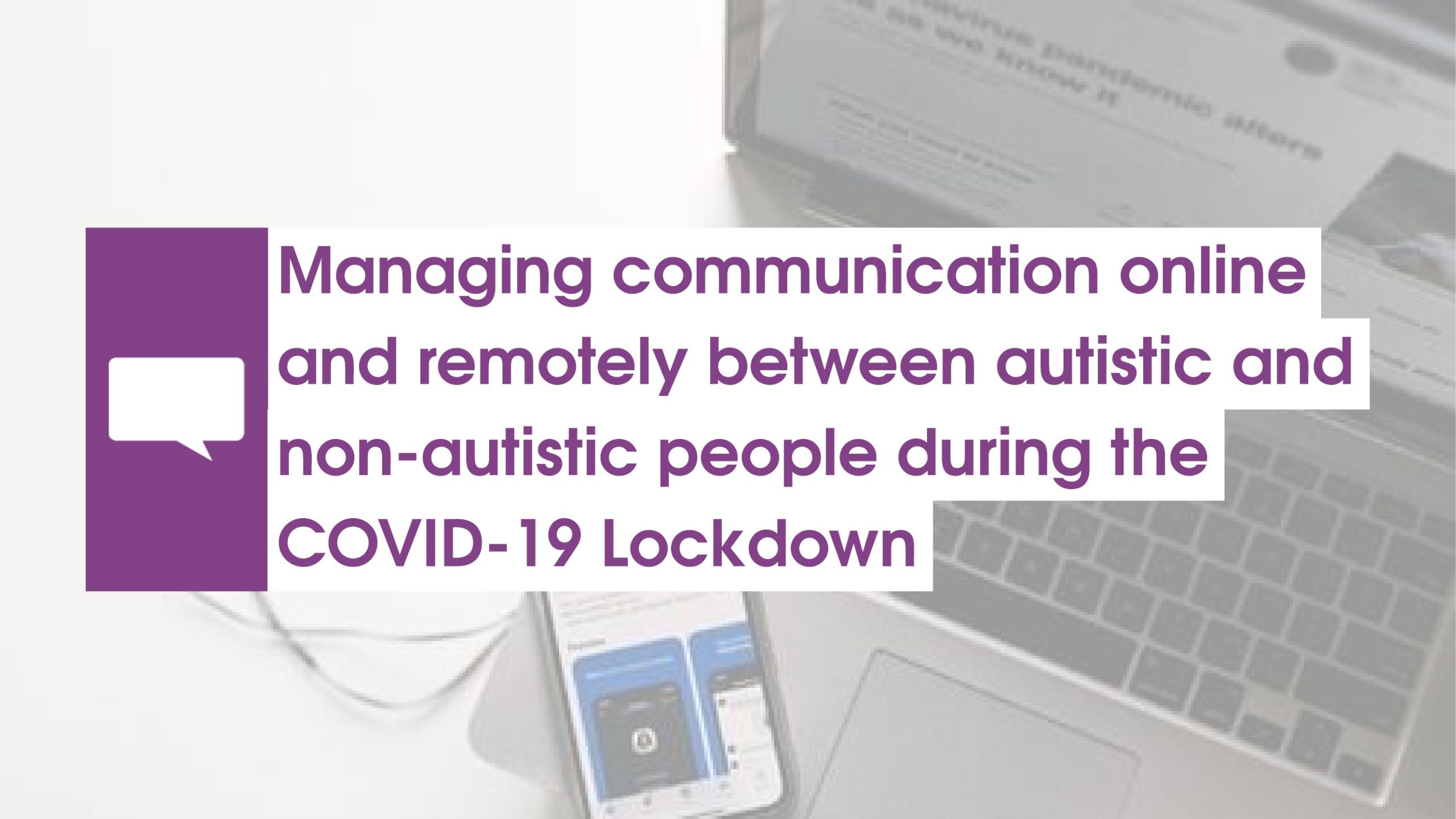During the lockdown, there has been a lot of talk of communication and the challenges that brings. In this blog post, our Peer Development Worker Gill Loomes has looked at communicating online, offline and remotely for autistic people and non-autistic people.
Key challenges and solutions:
- Inequality of resources – workplace audits of technology; recycling old tech
- Tech overload – appropriate technology
- Burnout – self-advocacy; non-autistics giving us time
Communication is at the heart of what we think we know about autism. For the past 80 years, those who have studied, and otherwise tried to understand autism, and the “essence” of what it means to be autistic, have placed differences in communication at the centre of their theorizing and their research – from the “social aloofness” of Kanner’s earliest accounts, describing what he called “early infantile autism” (Wing, 1996) to the more interactional, socially situated (and sympathetic) studies exploring interactional “rapport” between groups of autistic people, of non-autistic people, and mixed groups (Crompton et al., 2020), it is clear that those concerned with autism are, among other things, concerned with communication.
So, what does this mean for autistic people, and those who interact with us, during the ongoing COVID-19 “lockdown”?
What does the “lockdown” mean?
In response to the threat to public health posed by Coronavirus, the Secretary of State for Health and Social Care, Matt Hancock, issued a set of regulations called the Health Protection (Coronavirus Restrictions) (England) Regulations 2020 – you can find the regulations here. The Secretary of State is given the power to issue such regulations by the Public Health (Control of Disease) Act 1984. These are, according to any interpretation, extraordinary legal measures for extraordinary times.
The part of the Regulations that triggers the “lockdown” we are currently experiencing is Regulation 6 (which you can find here). Regulation 6 is headed “Restrictions on Movement”, and states (at (6)(1)) that for the duration of the “emergency period, no person may leave the place where they are living without a lawful excuse” – i.e. the default position is that we must stay at home.
The impact of “lockdown” on social communication, and what this means for autistic people
The lockdown means that the majority of us are remaining at home most of the time; and activities like work, socialising with friends, and keeping in touch with our loved ones are now taking place via online/remote technology – using phones or computers to talk with either audio or video links through Skype, Facetime, or Zoom; instant messaging on apps such as WhatsApp or Facebook Messenger; and perhaps attending team meetings or one to one supervision sessions for work using a platform such as Microsoft Teams. The opportunities and responsibilities associated with these technologies have become a part of our everyday working and social lives virtually overnight.
Research has been ongoing for decades, exploring how technology may be used to augment (broaden) and assist autistic communication (Mirenda, 2001), and to support “teaching social communication to individuals with autism” (Wainer et al., 2011); including through the use of “mainstream” technology such as iPads (Boyd et al., 2015).
However, my experience in recent weeks has shown me that while technology offers a range of benefits to autistic and neurotypical people alike for keeping lines of communication open, and while at the current time our use of online and remote technologies is more a necessity than a choice, the situation is not without its challenges.
Some of these apply across society, some are specific to autistic people, and some are general challenges that have a particular impact on autistic people. Here are some of the communication challenges I have observed since the COVID-19 “lockdown” began, along with my thoughts on how we might address them:
- The Challenge: Inequality of resources – Not everyone has access to the smart phones, tablets, and computers, or the broadband connections required to keep up with the technological demands of communicating during the COVID-19 “lockdown”. This inequality was, of course, true before the “lockdown”, but the challenge has become immeasurably more of an issue since face-to-face communication with anyone other than those in our “household” became all but impossible.
This is a challenge across society. However, it can raise a need for self-advocacy that can, in itself, create a “communication demand” for autistic people – e.g. where the autistic person has to explain to their line-manager at work what devices and other technologies are available to them. - Possible Solutions: Workplaces could organise audits of the technologies and devices available to each employee. This could also capture information about any equipment to which an employee has access, but which they don’t feel comfortable using; and any equipment to which a person doesn’t currently have access, but which they feel they need. This would especially benefit autistic employees who may struggle to identify the “correct” means of raising such issues.
Also, as a society, we could organise redistribution of equipment we no longer personally use – e.g. old smart phones and tablets, to people who need such equipment but cannot afford it. Devices and internet access are no longer the “luxuries” much of society sees them as being. They are a necessity, and can be a means of upholding human rights – such as, in some circumstances, the right to privacy and a family life.
- The Challenge: “Tech-Overload” – It is great having lots of options to “play with”, and different devices or platforms offer advantages and disadvantages, depending on the aims of communication. However, it can be extremely overwhelming trying to familiarise yourself with multiple new systems.
You might find that your family members are desperate to Skype with you, while you’re struggling to understand Zoom for work meetings. Or some friends might use FaceTime, while others insist on calling you over WhatsApp.
In the rush to adjust to our new circumstances, it is not surprising that we reach for all the options available to us. However, this can quickly become overwhelming in itself, particularly as people who work in multiple roles, in multiple teams or organisations may be finding themselves needing to adjust to several different ways of achieving the same form of online/remote communication in each of their different roles.
For autistic people, the challenge can potentially have a greater impact as our sensory processing faculties may rely on visual “cues” (such as picture symbols or colour-schemes) to differentiate between different apps or functionalities – and many of these are remarkably similar across platforms, making it hard for us to “process” what we see on the screen at any one time.
Likewise, social communication challenges we experience in face-to-face communications can be heightened when using remote/online technology (e.g. many of us find it hard to negotiate turn-taking in conversations and might rely on watching the mouths of our conversation partners to spot our “cue” to speak. This becomes impossible when we can’t see the face of the person we’re interacting with).
When we are co-present with our communication partners, there is the potential for them to “spot” that we are struggling and experiencing distress, giving them the opportunity to offer help (e.g. some autistic people may flap their arms, or rock, or appear distressed in other ways if they become overwhelmed by interactional demands). This potential for noticing and helping can be lost when communicating remotely, leading to a higher likelihood of autistic meltdowns or shutdowns. - Possible Solutions: When we are arranging to communicate with each other remotely, we need to consider which technology is going to be most appropriate for what we are trying to achieve. There are several things that can help us with this decision – e.g.
- Do we need visuals? Or are we comfortable with focusing on audio-only?
- Would text-based interaction be useful, as it gives us a record of what has been said, and provides the opportunity to process and reflect?
- How many passwords and other pieces of information are required? Multiple steps of accessing an app can be challenging for people experiencing challenges with executive functioning – a common experience for many autistic people.
- Which technologies are the people participating in the interaction most familiar and comfortable with? Can we go with those?
- Choice is key – particularly when planning to communicate with an autistic person, make it explicit that (if) they have a choice as to how to communicate.
Alongside considering these, and other questions, when we are scheduling interactions using remote/online technologies, we need to give ourselves and each other the time and “breathing space” to get to grips with unfamiliar devices, apps, and other platforms.
This is particularly applicable to workplace situations, so it is especially important that people with managerial responsibilities ensure that there is sufficient time for the people they manage to become comfortable with the equipment and platforms they are using – especially if they are then going to be using these to communicate with clients or customers.
- The Challenge – “Burn-out”: Social communication between autistic and neurotypical people can be challenging in “normal” circumstances. For autistic people especially, it can be a source of anxiety, frustration, depression, and exhaustion; particularly as we must also negotiate a world that constantly suggests that our communication skills are “lacking” or “deficient”.
In current circumstances – as possibly even greater demands are placed on our communication skills, across a wide range of potentially unfamiliar media, and interacting with people who themselves may be struggling with unfamiliar technologies – all happening in a social context that is unprecedented, uncertain, and possibly frightening, it will not be surprising if we begin to find communication a challenge that triggers autistic burnout. - Possible Solutions – As autistic people, we can help ourselves by monitoring the communication demands we place on ourselves. We can keep track of our schedules, and see how much time we are spending interacting in different ways, and we can ensure that we also schedule in “down-time”, in which we can avoid forms of communication that cause us (di)stress, and replenish our supplies of energy and self-esteem.
We can develop our self-advocacy skills by reflecting on the forms of communication, and the social communication situations that challenge us, and developing ways to articulate these challenges to others. This could involve developing a “passport” or set of “scripts”, setting out what we feel comfortable with, and what is inaccessible to us (e.g. “I find using a phone very inaccessible, but I am very comfortable communicating using Skype or FaceTime on my tablet” or “I’m happy to attend this meeting using Zoom, but I’ll need to schedule in some time in my working hours next week to familiarise myself with Zoom”).
If we think about this in advance, it is likely to help us to negotiate arrangements when the need presents itself. As neurotypical people interacting with autistic people, give us the time and space to reflect on what is working for us, and what is making us uncomfortable or causing us distress.
It can take some time for this to become apparent to us, so you can help by being flexible; letting us know that it is fine to use different types of technology at different times. And as a society in general, we can help each other by sharing what is, and isn’t working for us. In particular, it is possible that autistic people in isolation may reach the conclusion that their struggles in managing the demands of remote and online communication during “lockdown” is an individual failing, and/or a facet of their autism.
Creating a culture that is understanding of the practical and emotional struggles we currently face, and generous with the strategies and tools we develop to overcome these is likely to benefit us all.
Lastly, I have focused here on the communication challenges that may be facing members of the autistic community during the COVID-19 “lockdown”. However, it is important to highlight that many in our community are extremely skilled in using remote/online platforms, and technologies, to communicate successfully and efficiently.
Society as a whole should recognise this; and be prepared to learn from all autistic “voices” – especially those that have been using technologies to support their communication since prior to the COVID-19 outbreak, and that in “normal” circumstances so often go unheard.










